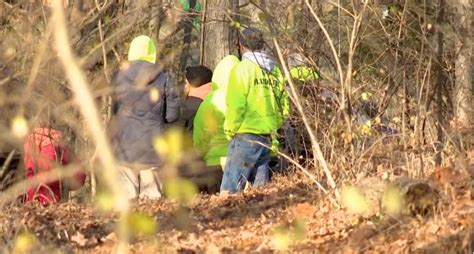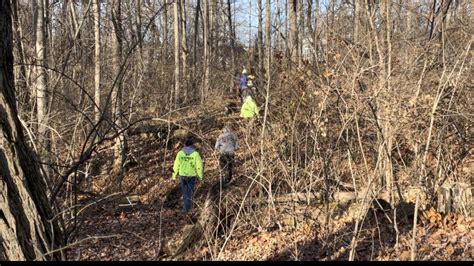
Bones discovered near the former Indiana property of Herb Baumeister, a suspected serial killer who targeted gay men in the 1990s, are undergoing renewed scrutiny as investigators attempt to identify potential additional victims. The remains, initially found decades ago, are being re-examined using advanced DNA technology, raising hopes of bringing closure to families who have long sought answers about their missing loved ones.
The Hamilton County Coroner’s Office and the FBI are collaborating on the investigation into the bones found on and near Fox Hollow Farm, the sprawling estate once owned by Baumeister, who committed suicide in 1996 while under investigation. The recovered remains consist of over 10,000 fragmented or complete bone pieces, many of which were initially dismissed as animal remains. Now, with advancements in forensic science, investigators are revisiting the evidence to determine the identities of the deceased and potentially link them to Baumeister.
“We are hopeful that with continued hard work and collaboration, we can give these unidentified victims a name and return them to their families,” stated Hamilton County Coroner Jeff Jellison.
Baumeister, a wealthy businessman, ran a string of thrift stores in the Indianapolis area. He became a suspect in the disappearances of several men who frequented gay bars in the city. Investigators believe Baumeister lured his victims to his 18-acre property, where he allegedly murdered them and disposed of their remains.
The initial investigation in the mid-1990s led to the discovery of skeletal remains in the woods behind Baumeister’s house. At the time, authorities identified remains belonging to at least eleven individuals. However, due to the limited forensic technology available, many bone fragments remained unidentified.
The renewed investigation aims to utilize advanced DNA analysis techniques, including mitochondrial DNA sequencing and advanced isotopic analysis, to potentially identify more victims. These methods can extract DNA from degraded or fragmented bone samples and compare them to DNA profiles of missing persons.
The recent efforts also include reviewing old case files, interviewing witnesses, and collaborating with national missing persons databases. Investigators are urging families of men who disappeared in the Indianapolis area during the 1980s and 1990s to submit DNA samples to help with the identification process.
The Baumeister case has long haunted the Indianapolis community, particularly the LGBTQ+ community, which feels that the disappearances were not taken seriously enough at the time. The renewed investigation offers a glimmer of hope for long-awaited justice and closure for the victims and their families.
“It’s a painful reminder of a dark chapter in our city’s history, but it’s also an opportunity to finally bring some peace to the families who have suffered for so long,” said a local LGBTQ+ activist.
The investigation is ongoing, and authorities have not released any new information about potential victims. However, they remain committed to pursuing every lead and utilizing every available resource to bring closure to this decades-old case. The sheer volume of remains poses a significant challenge, requiring painstaking forensic work and careful analysis. The process is expected to take months, if not years, to complete.
The case highlights the importance of continued advancements in forensic science and the dedication of law enforcement to solving cold cases. It also serves as a reminder of the vulnerability of marginalized communities and the need for vigilance in protecting them from violence.
The story of Herb Baumeister is one of deception and brutality. He presented himself as a successful businessman and family man, but behind this facade, he allegedly harbored a dark secret. His victims were primarily gay men, many of whom were vulnerable and marginalized. The fact that their disappearances were not initially investigated with the same urgency as other missing persons cases underscores the systemic biases that existed at the time.
Baumeister’s method of operation involved frequenting gay bars and attempting to lure men back to his property. Some of his victims were known to be struggling with addiction or homelessness, making them even more vulnerable to his predatory behavior. The remains found on his property suggest that he may have engaged in ritualistic or sadistic acts.
The initial investigation into Baumeister began in 1994, after his teenage son found a human skull in the woods behind the house. Baumeister dismissed it as a medical skeleton he had acquired for his own amusement. However, investigators became suspicious after several men disappeared from the Indianapolis gay scene.
Police obtained a warrant to search Baumeister’s property in 1996. Before they could execute the warrant, Baumeister fled to Canada and committed suicide. In his suicide note, he denied any involvement in the disappearances, but authorities remained convinced of his guilt.
The discovery of the remains on Fox Hollow Farm sent shockwaves through the Indianapolis community. The case became a national sensation, highlighting the vulnerability of gay men and the importance of taking all missing persons cases seriously. The initial investigation was hampered by limited resources and technology, but investigators were able to identify the remains of several victims.
The renewed investigation represents a second chance to bring closure to the families of the missing men. Advanced DNA technology has made it possible to identify remains that were previously unidentifiable. Investigators are also re-examining old case files and interviewing witnesses to gather new information.
The Baumeister case is a stark reminder of the importance of justice and accountability. It is also a reminder of the need to protect marginalized communities from violence and discrimination. The renewed investigation offers a glimmer of hope that the truth will finally come to light and that the victims will finally receive the recognition and respect they deserve.
The Fox Hollow Farm property has since been sold and redeveloped. The house where Baumeister lived has been torn down, and new homes have been built on the land. However, the memory of the crimes committed there remains a painful chapter in the history of Indianapolis.
The renewed investigation into the Baumeister case is a testament to the dedication of law enforcement and the power of forensic science. It is also a testament to the resilience of the LGBTQ+ community and their unwavering commitment to justice.
Investigators are urging anyone with information about the case to come forward. They are also encouraging families of men who disappeared in the Indianapolis area during the 1980s and 1990s to submit DNA samples to help with the identification process.
The Baumeister case is a complex and tragic story. It is a story of loss, betrayal, and the pursuit of justice. The renewed investigation offers a glimmer of hope that the truth will finally be revealed and that the victims will finally receive the peace they deserve. The hope is to offer families closure and a sense of justice they’ve been deprived of for so long. The process, though painstaking and potentially lengthy, represents a commitment to remembering the victims and holding the perpetrator accountable, even posthumously. The case also highlights the evolution of forensic science and its critical role in solving cold cases and bringing justice to victims and their families.
The investigation is proceeding cautiously and methodically. Each bone fragment is being carefully examined and analyzed. DNA samples are being extracted and compared to existing databases. Investigators are also working to reconstruct the events that led to the deaths of the victims. The goal is to build a solid case that can withstand legal scrutiny and bring closure to the families of the missing men.
The Baumeister case also raises important questions about the role of the media in covering sensitive cases. The media has a responsibility to report the facts accurately and fairly, but it also has a responsibility to protect the privacy of victims and their families. The Baumeister case was a media circus, and the victims and their families were often subjected to intense scrutiny. It is important for the media to learn from this experience and to approach similar cases with greater sensitivity and respect.
The renewed investigation into the Baumeister case is a reminder that justice can be slow, but it is never too late. Even after decades, it is still possible to bring closure to the families of the missing men and to hold the perpetrator accountable for his crimes. The case also serves as a warning to others who would prey on vulnerable populations. Law enforcement is committed to protecting all members of the community, regardless of their sexual orientation or other characteristics.
The Baumeister case is a tragedy that will forever be etched in the history of Indianapolis. But it is also a story of hope, resilience, and the pursuit of justice. The renewed investigation offers a glimmer of hope that the truth will finally be revealed and that the victims will finally receive the peace they deserve.
The LGBTQ+ community has been deeply affected by the Baumeister case. Many members of the community feel that the disappearances were not taken seriously enough at the time and that the victims were not treated with the same respect as other missing persons. The renewed investigation offers an opportunity to right these wrongs and to show the LGBTQ+ community that their lives matter.
The Baumeister case is a reminder of the importance of vigilance and awareness. It is important to be aware of the dangers that exist in the world and to take steps to protect oneself and others. It is also important to be aware of the signs of abuse and to report any suspicions to law enforcement.
The Baumeister case is a complex and multifaceted story. It is a story of crime, loss, justice, and resilience. The renewed investigation offers a glimmer of hope that the truth will finally be revealed and that the victims will finally receive the peace they deserve. The case also serves as a reminder of the importance of protecting vulnerable populations and of holding perpetrators accountable for their crimes.
The ongoing investigation into the Baumeister case highlights the dedication and perseverance of law enforcement and forensic scientists. Their relentless pursuit of justice underscores the commitment to identifying the unidentified and bringing closure to families who have suffered for decades. The use of advanced DNA technology and meticulous examination of evidence demonstrate the power of science in solving cold cases. The case serves as a beacon of hope for other families of missing persons, reminding them that their loved ones are not forgotten and that justice may still be possible, even after years of uncertainty.
The efforts to identify the remains found near Baumeister’s property are not just about solving a crime; they are about restoring dignity to the victims and providing solace to their families. The process of identifying remains involves meticulous work, including anthropological analysis, dental records comparison, and DNA testing. Each step is crucial in piecing together the identities of the individuals and uncovering the circumstances surrounding their deaths. The collaboration between law enforcement, forensic experts, and community members is essential to the success of the investigation.
The Baumeister case also underscores the importance of addressing societal biases and prejudices that can hinder investigations and perpetuate injustice. The fact that the disappearances of gay men were initially overlooked or dismissed highlights the need for greater awareness and sensitivity towards marginalized communities. By acknowledging and confronting these biases, law enforcement can improve their response to missing persons cases and ensure that all victims receive equal attention and justice. The renewed investigation represents a step towards rectifying past shortcomings and demonstrating a commitment to inclusivity and equality.
The legacy of Herb Baumeister serves as a chilling reminder of the darkness that can exist beneath the surface of seemingly normal individuals. His ability to deceive and manipulate those around him allowed him to perpetrate his crimes for years without detection. The case underscores the importance of vigilance and critical thinking in assessing individuals and situations. It also highlights the need for strong support systems and resources for vulnerable populations to prevent them from becoming victims of violence. The Baumeister case should serve as a cautionary tale, reminding us of the importance of safeguarding our communities and protecting those who are most at risk.
The identification of additional victims in the Baumeister case would not only bring closure to their families but also provide valuable insights into Baumeister’s modus operandi and the full extent of his crimes. Each identified victim represents a piece of the puzzle, helping investigators to understand the patterns and motivations behind his actions. The information gathered from these identifications could also be used to prevent similar crimes from happening in the future. The pursuit of justice in the Baumeister case is not just about the past; it is also about protecting future generations from the horrors of violence and exploitation.
The renewed investigation into the Baumeister case reflects a commitment to justice, remembrance, and the unwavering pursuit of truth. It is a story of resilience, hope, and the enduring power of the human spirit to overcome adversity. The efforts to identify the remains found near Baumeister’s property represent a tribute to the victims and their families, ensuring that their stories are not forgotten and that their lives are honored. The case serves as a reminder that even in the face of unimaginable tragedy, there is always hope for healing, reconciliation, and justice. The Baumeister case stands as a testament to the importance of remembering the past, confronting the present, and building a future where all individuals are valued, respected, and protected.
The investigation continues to unfold, and further updates are expected as forensic analysis progresses. The Hamilton County Coroner’s Office and the FBI remain steadfast in their commitment to providing answers and closure to the families affected by this horrific case. The community remains hopeful that the renewed efforts will bring forth new information and that the victims will finally be identified and laid to rest with dignity. The Baumeister case serves as a somber reminder of the importance of vigilance, justice, and the unwavering pursuit of truth.
FAQ:
-
What is the Baumeister case about? The Baumeister case involves Herb Baumeister, a wealthy businessman suspected of being a serial killer who targeted gay men in the Indianapolis area during the 1980s and 1990s. Skeletal remains were found on his property, Fox Hollow Farm, after he became a suspect in the disappearances of several men. Baumeister committed suicide in 1996 while under investigation.
-
Why is the Baumeister case back in the news? The case is back in the news because investigators are re-examining the bones found on Baumeister’s property using advanced DNA technology. The goal is to identify additional victims and potentially bring closure to families of missing men from that era.
-
What kind of DNA technology is being used in the renewed investigation? Investigators are using advanced DNA analysis techniques, including mitochondrial DNA sequencing and advanced isotopic analysis, to extract DNA from degraded or fragmented bone samples. These methods can then compare the DNA to profiles of missing persons.
-
How many victims have been identified so far in the Baumeister case? During the initial investigation in the mid-1990s, authorities identified remains belonging to at least eleven individuals. The renewed investigation aims to identify additional victims who were previously unidentifiable due to technological limitations.
-
What should I do if I have information about the Baumeister case or if I think my family member might be a victim? Investigators are urging anyone with information about the case to come forward. Families of men who disappeared in the Indianapolis area during the 1980s and 1990s are encouraged to submit DNA samples to help with the identification process. Contact the Hamilton County Coroner’s Office or the FBI for more information.









